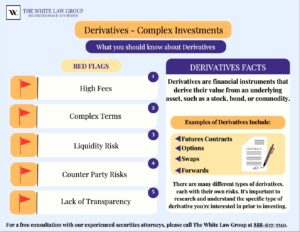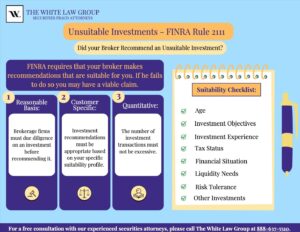Overview and Risks of Options Trading
Have you lost your investment portfolio in trading options? If so, the attorneys at The White Law Group may be able to assist you in recovering your investment losses. Due to the complexity and risks, options trading is not appropriate for all investors.
FINRA Award for Unsuitable Options Strategy
According to reports this week, a FINRA panel ordered a former advisor to pay $664,901 for an unsuitable options strategy. FINRA is the self –regulator that oversees brokers and brokerage firms but does not participate in deciding awards.
The FINRA panel ordered the former financial advisor to pay more than $600,000 for recommending risky options strategies to a group of Alabama investors though his investment advisory firm. The arbitration claim, filed in July 2021, alleged unsuitability; negligent misrepresentation and suppression; breach of contract; controlling person liability and violation of the Alabama Securities Act.
FINRA Fines Webull $3 Million for Allowing Unqualified Options Traders
In 2021, FINRA announced it would be launching an examination sweep investigating the supervision, communications and diligence surrounding the opening of options accounts. On March 9, 2023, FINRA fined Webull Financial LLC $3 million for not exercising reasonable due diligence before it approved customers for options trading; not maintaining a supervisory system reasonably designed to identify and respond to customer complaints; and not reporting certain written customer complaints to FINRA as required.
Between December 2019 and July 2021, FINRA discovered that Webull allegedly failed in due diligence before approving customers for options trading. The automated system used to review applications didn’t cross-reference customer data, resulting in approvals for ineligible customers, including those under 21 and lacking required options trading experience.
What is Options Trading?

There are two types of Options — puts and calls. The set price that the option refers to is called a strike price. There are several factors that will impact the price of an option – the level of the underlying market compared to the strike price, the time the option has left before expiration, and the underlying volatility of the market. Options give you the right, but not the obligation, to buy or sell at a set price on or before a certain date. One option equals 100 shares of stock.
Options are available for short and long-term trading. Offers range from daily, which would expire at the end of the underlying market on the particular day you place the trade, to weekly, monthly, and quarterly.
Risks of Option Trading
It’s important to thoroughly research and understand these risks before engaging in options trading. If you’re new to options, consider starting with a small investment, educating yourself on different strategies, and seeking guidance from experienced traders or financial professionals.
Limited Timeframe: Keep in mind that options contracts have expiration dates. If you don’t exercise your option before the expiration, it could become worthless, causing you to lose the premium you paid.
Potential Loss of Premium: Remember that the premium you pay to buy an option is non-refundable. If the trade doesn’t go in your favor, you might lose the entire premium amount.
Volatility Impact: Understand that options can be highly affected by market volatility. Rapid price swings can impact the value of options, making them riskier during turbulent market conditions.
Wrong Prediction: Be aware that if your market prediction doesn’t come true, you might not only lose the premium but also the potential profit you were hoping for.
Lack of Ownership: Realize that options don’t grant ownership of the underlying asset. You won’t receive dividends or voting rights, which can impact your overall return on investment.
Complexity: Recognize that options trading can be complex. Different strategies, expiration dates, and strike prices can make it challenging to fully understand the potential outcomes of your trades.
Liquidity Concerns: Consider that some options might have low trading volumes, resulting in wider bid-ask spreads. This can make it harder to enter and exit trades at desirable prices.
Margin Requirements: Understand that options trading might involve margin, which means you’re trading with borrowed money. While this can amplify gains, it also increases potential losses.
Assignment Risk: Be aware that if you sell an option, there’s a chance you could be assigned the obligation to fulfill the terms of the contract, like buying or selling the underlying asset.
Overleveraging: Guard against the temptation to overleverage by trading too many contracts or investing more than you can afford. This can magnify losses and increase overall risk.
Commissions and Fees: Keep in mind that options trading often involves transaction costs, including commissions and fees. Frequent trading can accumulate expenses over time.
Market Timing: Recognize that timing the market accurately is difficult. Even if you predict the right direction, mistiming your entry or exit can still result in losses.
Complex Taxation: Realize that options trading can have complex tax implications. Different strategies might result in different tax treatments, which could affect your overall profitability.
Breakdown of Options Strategies
Covered Call A covered call is when the investor sells a call option and owns the shares being optioned. Covered calls are for beginners who are just getting started investing in options. They have the same risk as a short put with a bullish assumption. A covered call is when the investor owns a naked stock (a stock without any options on it), and it must go up to be profitable. When a call is sold against the shares, this reduces the cost basis. Now the stock can stay the same and the investor would receive the premium paid for the option as long as the stock stays out of the money, or the stock could drop a little and would still be profitable due to the premium paid.
Naked Call A naked call on the other hand, is the opposite of a covered call. A naked call is a put option where the stocks are not owned or the asset that is being optioned. The seller in the naked call hopes the underlying equity or stock stays relatively the same or rises modestly. In this case the seller will retain the premium paid. This becomes a riskier position when the seller does not have sufficient funds to cover the purchase of the underlying equity.
Protective Put This strategy is where an investor buys shares of an asset or stock, and at the same time buys enough put options to cover those shares. In steadiness this strategy will have the same net payoff as buying a call option.
Bear Put Spread This strategy is a vertical spread strategy. Investors will instantaneously purchase put options at a specific strike price and sell the same number of puts at a lower strike price. Both contracts would be for the same asset and have the same expiration date. This is used when the trader is bearish and expects the assets market value to diminish. This method offers both limited gains and losses.
Bull Call Spread In this strategy, an investor will instantaneously purchase a call option at a specific strike price and sell the same number of calls at a higher strike price. Again, both contracts will have the same expiration date. This strategy is often used when an investor is bullish and expects a reasonable rise in the price of the asset.
Long Straddle This strategy comprises purchasing both a call and put option on some interest rate, index, or other underlying. The two options are bought at the same strike price and expire at the same time. The owner of a long straddle makes a profit if the underlying price moves a long way from the strike price, either above or below. Thus, an investor may take a long straddle position if he/she thinks the market is highly volatile but does not know which direction it is going to move. This position is a limited risk, since the most a purchaser may lose is the cost of both options. At the same time, there is unlimited profit potential.
Long Strangle This strategy involves going long; buying both a call and put option of the same security. Like a straddle, the option expires at the same time, but unlike a straddle, the options have different strike prices. A strangle can be less expensive than a straddle if the strike price is out-of-the-money. The owner of a long strangle makes a profit if the price moves far enough away from the current price, either above or below. Thus, an investor may take a long strangle position if he/she thinks the underlying securities is highly volatile but does not know which direction it is going to move. This position, just like the long straddle, is a limited risk, since the most a purchaser may lose is the cost of both options. At the same time, there is unlimited profit potential.
Butterfly Spread Additionally, a butterfly spread is a limited risk, non-directional options strategy that is designed to have a high likelihood of earning a limited profit when the future volatility of the primary asset is expected to be lower or higher than the implied volatility when long or short respectively.
Iron Condor The iron condor is an option trading strategy utilizing a combination of two other options, put spread and call spread. Both put and call spread will have the same expiration date and four different strikes. The iron condor is selling both sides of the asset by simultaneously shorting the same number of calls and puts, then covering each position with the purchase of further out of the money call(s) and put(s) respectively. For a good example of options strategies missteps, See: UBS Hit with $1.9 Million in another UBS YES FINRA Suit
Iron Butterfly Alternatively, the iron butterfly, also known as the ironfly, is a strategy that involves buying four different contracts at three different strike prices. It is a limited risk, limited profit trading strategy that is structured for a larger probability of earning smaller limited profit when the asset is perceived to have low volatility.
Due Diligence and Suitability Rules – FINRA Rule 2111

FINRA (Financial Industry Regulatory Authority) is a self-regulatory organization that oversees the securities industry in the United States. The suitability rule (FINRA Rule 2111) is a regulation imposed by the FINRA that requires brokers and financial advisors to recommend investments that are suitable for their clients based on their financial situation, investment objectives, risk tolerance, and other relevant factors.
Primary Broker Abuses & Warning Signs
The following are warning signs that your broker may not have your best interests in mind.
If you are receiving a frequent number of buy/sell confirmations, your broker may be churning your account. This is the primary retail risk posed by options trading. If your broker is avoiding your calls or not responding to your emails in a timely manner, or doesn’t call you prior to making trades, that is another warning sign.
Trading on margins is another red flag. Trading on margins means you are taking out a loan from the brokerage firm to invest in more securities than you can buy with your available cash. Not only are you risking cash you do not currently have, which is also known as gambling, you are also paying interest on the same funds.
Similarly, if your broker suggests taking a 2nd mortgage on your home to invest, that would be a warning sign that he or she is not looking out for your best interest. Ask detailed questions and don’t turn a blind eye, you are your own best advocate.
FINRA Arbitration Attorneys
Broker dealers are required to perform adequate due diligence on any investment they recommend and to ensure that all recommendations are suitable for the investor. Brokerage firms that fail to do so may be held responsible for any losses in a FINRA arbitration claim.
Experienced securities attorneys can help you through the FINRA arbitration process. The intricacies of FINRA arbitration can be challenging to navigate, and a skilled attorney with expertise in securities law can significantly enhance your prospects of a successful outcome.
The White Law Group, LLC is a national securities fraud, securities arbitration, investor protection, and securities regulation/compliance law firm with offices in Chicago, Illinois and Seattle, Washington. We represent investors across the country in claims against their brokerage firms. For more information on the firm and its representation of investors, visit https://whitesecuritieslaw.com.
If you believe you have suffered financial losses due to options trading with your investments, the attorneys at The White Law Group may be able to help you recover your investment losses. Please call our offices at (888) 637-5510 for a free consultation with a securities attorney.
Tags: Options Trading Last modified: August 18, 2023





